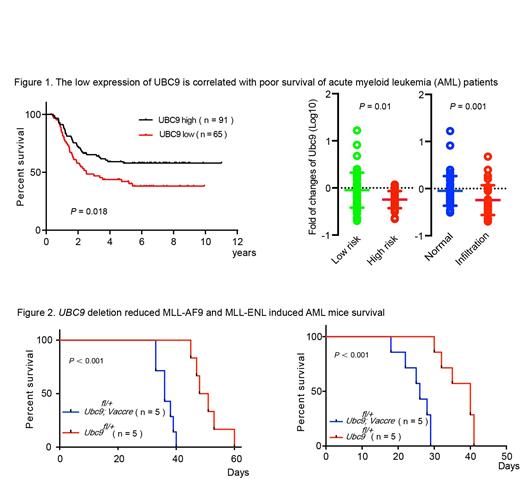Acute myeloid leukemia (AML) is the most common acute leukemia in adults and is a disease of heterogeneous clonal hematopoietic progenitor cells. Despite the relentless development of therapeutic options, including chemotherapy, and identification of many new therapeutic targets, the prognosis of AML is still poor, with a 5-year survival rate of approximately 35% in patients younger than 60 years old and 10% in patients older than 60 years, which may be due to the high degree of AML heterogeneity. Targeting the shared mechanisms of action among subclones has emerged led to find novel strategies, such as targeting protein post post-translational modification. Here we show that the impact of the UBC9 (the only E2 conjugation enzyme) and its related SUMOylation, a critical and reversible posttranslational modification as ubiquitination, on AML progression, to provide novel and potent sight for AML therapy.
To identify the role of UBC9 expression in the clinical outcome of AML patients, we measured the expression of key SUMOylation genes, including SAE1, UBA2, UBC9, SUMO1, SUMO2, SUMO3, PIAS1, PIAS2, PIAS3, PIAS4, CBX4, and RANBP2, in the TCGA dataset (n=164) by using a multivariate survival curve based on the online tool SurvExpress. Our results showed that the survival probability curves of the low- and high-risk groups were significantly different due to the differences in the levels of expression of key SUMOylation genes ( p = 0.0011), and we found that the expression level of UBC9 was lower in the high-risk group than in the low-risk group. We next analyzed the UBC9 expression level and the prognosis of AML patients from the Therapeutically Applicable Research To Generate Effective Treatment dataset (n=156), which showed that AML patients with low UBC9 expression showed shorter overall survival ( p = 0.018)(Figure 1). In addition, real-time PCR showed that the UBC9 expression level in bone marrow samples from patients with de novo AML was significantly downregulated in both the high-risk patients based on National Comprehensive Cancer Network guidelines and the liver or spleen enlargement patients ( p = 0.01 and p = 0.001, respectively) (Figure 1).
We used RNA interference system to knock out Ubc9 in a mouse model of MLL-AF9 and MLL-ENL induced AML. We observed the survival of AML mice and found that Ubc9 fl/+;Vav-Cre recipient mice showed a significantly shorter survival time than Ubc9 fl/+ mice (Figure 2). In addition, apoptosis experiments revealed reduced apoptosis of leukemia cells and leukemia stem cells in Ubc9 fl/+;Vav-cre mice. HE staining showed significantly higher leukemia cell infiltration in the livers, meninges, and kidneys of Ubc9 fl/+;Vav-cre mice compared to Ubc9 fl/+ mice. Transwell experiments indicated that Ubc9 deficiency resulted in increased migration of leukemia cells. Colony forming assay demonstrated that Ubc9-deficient leukemia cells formed significantly larger colonies. Flow cytometry analysis showed that Ubc9-deficient leukemia cells expressed high levels of c-kit and low levels of Mac1.
To further elucidate the role of UBC9 in human AML cells, we constructed UBC9 deficient KG1 and K562 cell lines by using CRISPR-Cas9 technology. The UBC9 KD cell lines presented the same phenotype such as the increase of cell viability and the enhancement of invasiveness.
To better understand the role that UBC9 plays in AML cell biology, we performed a system-level approach based on quantitative SUMO proteomic analysis to identify potential UBC9 substrates and then identified PARP1 with SUMOylation site lysine residue 486 (K486) by multiomics analysis. Finally, we validated that UBC9-mediated PARP1 SUMOylation played an important role in AML progression by activating the NF-kappa B pathway via the site-directed mutation of PARP1 (K486R) in UBC9-KO AML cells by using western blot and Co-immunoprecipitation.
Together, our study revealed that UBC9 KO accelerated AML progression and enabled us to contrast global SUMOylation profiles of UBC9 in AML cells. In addition, we found that the PARP1 SUMOylation-mediated NF-κB pathway activation is a positive regulatory mechanism in the tumorigenesis of AML. These findings may provide potential clinical implications for AML treatment.
Disclosures
No relevant conflicts of interest to declare.


This feature is available to Subscribers Only
Sign In or Create an Account Close Modal